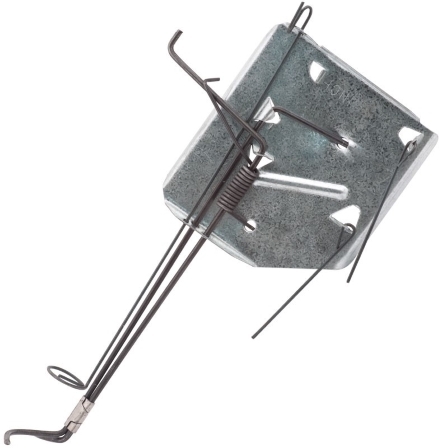I lost a fig and an apricot to moles or mole salamanders last year. They were both planted in a hoop house and the next day the fig was completely gone. The apricot was the next victim and the mole left a little bit but not much. I have moles showing up all over this year in the garden, the hoop house, and a hole I was digging.
In my location, gophers and voles appear drawn to fig trees like they are candy. I plant all my figs in gopher baskets that degrade over several years. I haven’t had trouble with moles, but suspect that the baskets would work equally well against them.
I’ve had that problem with the garden - one day it’s there, the next it disappears down a hole.
If you have a disapearance like that, it is a good time/place to set a mouse trap. It is in your best interest to reduce the population.
To protect from voles, when I dig the hole, I line the circumference with 1/2" hardware cloth down to about 8-10 inches from the ground level. You can price it out for your area but it may be cheaper than the baskets designed for that purpose.
@cdnfruit, if you decide to go this route, you might consider the “Gophinator” traps.
I agree with @JustAnne4, FWIW. I’ve been surprised at how much damage one can do, so I find a noticeable impact by a little reduction.
I’ll add that from what I’ve seen, a plant of any size getting drug down a hole = gopher. Moles are generally insectivores, and voles nibble above, but mostly below, ground. I don’t think there is anything else around here that does underground damage (ground squirrels, etc.) though there are plenty of other critters out there. Photos of the mounds/holes/damage posted here could get some pointers re: what you are dealing with. I’ve gained skill in trapping gophers so I don’t have them anymore but they destroyed plenty around here for a while. If you’re dealing with a gopher, I suggest a cinch trap or two, and read up on technique (be careful!). I wrap everything in about a 12" diam., 2-ft long cylinder of 1/2" hardware cloth (wire mesh) when planted; 1ft above ground, 1ft below. If outside the big fence it gets a 4ft high cylinder of chicken wire fence, too. So far (1.5 yrs.) no more loss.

The only traps like this that I have run across are uncoated steel at the business end and that type will rust during ordinary use in my climate, making them effectively one-season only. The “gophinator” ones mentioned above work the same way as a cinch trap but are non-rusting stainless.
I’m in a wet climate here, too, but I think mine are galvanized. When I saw “gophinator” I thought Rodinator, as in the ones that go boom…sometimes really big boom. Those look like fun but kinda risky, and very expensive. (See YouTube if you aren’t familiar.) I just saw your first (?) post and I agree with the damage one unit can do. On the other hand, I got 5 out of one hole one time, in about ten days, because I was ‘working’ it before the next generation flew the coup, so to speak.
That’s nuts.
Do you remember who makes the galvanized traps?
The advantage to the cinch trap seems to be the easy way the mole is released. It isn’t clear from all the videos I watched how to release the mole from the gophinator.
Everyone has their constraints and mine is lack of hand strength and the whimp-factor of handling a dead rodent. I don’t mind cleaning and oiling the pins/trap with each use to make it last. So did someone see a video demo on how to release the rodent with the gophinator?
I have used both types of traps (I gave up the “cinch” for the other because of the aforementioned rust issue) and here are my thoughts on the concerns in your post:
Ease of releasing the varmit from both types of traps is about the same.
Whimp-factor between the two nets out about the same. The gophinator is a smaller trap so your hand is closer to the varmit (more yuck), but it’s a little easier to release tension on the trap and, when you do that, you can then free the varmit with distance-creating tool (less yuck), like whatever you use for digging to set the traps, which probably will be by your side.
The hand strength required to set the two is about the same. Setting the gophinator is a slightly more precise/error prone movement, but the cinch is a little more prone to error while tensioned and before in place (at least in my experience). The motion to set the gophinator is more rotational with the pressure on the pad of your thumb.
There are some other pluses and minuses of each, but, in my opinion, it’s a wash between the two aside from the rust.
I would not seriously consider getting uncoated cinch traps and trying to maintain them with oil. Either get Seedy’s galvanized ones or get the gophinators. To be clear on what parts were problematic for me, it’s not the flat, polygonal part of the trap, that part was galvanized on mine. The jaws, spring, trigger, and trip wires are what rusted for me. Here’s an explanation of maintenance on those where you can see the offending parts, e.g., the rusted spring in Figs. 12 and 19.
I order a pail of kaput rodent poison this time every year. It is supposed to be safer for non-target animals. I only use it in the nursery and where I see a lot of activity around young trees in the orchard. When I do lose a tree in the orchard to voles it gets replanted with a bunch of gravel.
Vohd and others: The only marking on the trap is: CINCH faintly stamped in the metal. I don’t know if that is a brand name or what. These traps are strong and potentially hazardous. You don’t want to get in their way.
The main plate on my type is galvanized; the wire parts aren’t but they seem to be a low-rust alloy. I did give them a shot of WD-40 about once a year when they were in active use. I think word got out…they called me the Gopher Whisperer, but what I would whisper is, “You’re next”…I think I freaked’em out.
On a lighter note, the nature of trapping is that sometimes the critter isn’t dead and a bucket of water is needed to finish the job. The hand strength needed, the potential finger hazard, and some ickiness are part of the deal. If it’s too much, maybe a friend could help. The damage done to plants can be extensive. I have used Terad-3 for voles. It works and it’s expensive and in my situation (about two acres) it’s untenable. I use the hardware cloth cylinders and am turning my field into a mowed lawn.
